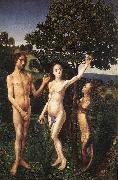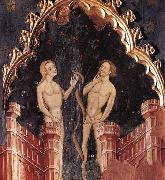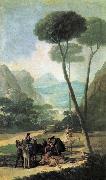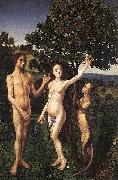Wholesale Oil Painting No Minimum |
|||||||||||
|
|
|||||||||||

|
|||||||||||
|
|
|
||||||||
Hugo van der Goes1440-1482 Flemish Hugo van der Goes Galleries Hugo became a member of the painters' guild of Ghent as a master in 1467. In 1468 he was involved in the decoration of the town of Bruges in celebration of the marriage between Charles the Bold and Margaret of York and he provided heraldic decorations for Charles's joyeuse entr??e to Ghent in 1469 and again in 1472. He was elected dean of the Ghent guild in 1473 or 1474. In 1475, or some years later, Hugo entered Rooklooster, a monastery near Brussels belonging to the Windesheim Congregation, and professed there as a frater conversus. He continued to paint, and remained at Rooklooster until his death in 1482 or 1483. In 1480 he was called to the town of Leuven to evaluate the Justice Scenes left unfinished by the painter Dieric Bouts on his death in 1475. Shortly after this, Hugo, returning with other members of his monastery from a trip to Cologne, fell into a state of suicidal gloom, declaring himself to be damned. After returning to Rooklooster, Hugo recovered from his illness, and died there. His time at Rooklooster is recorded in the chronicle of his fellow monk, Gaspar Ofhuys. A report by a German physician, Hieronymus M??nzer, from 1495, according to which a painter from Ghent was driven to melancholy by the attempt to equal the Ghent Altarpiece, may refer to Hugo. His most famous surviving work is the Portinari Triptych (Uffizi, Florence), an altarpiece commissioned for the church of San Egidio in the hospital of Santa Maria Nuova in Florence by Tommaso Portinari, the manager of the Bruges branch of the Medici Bank. The triptych arrived in Florence in 1483, apparently some years after its completion by van der Goes. The largest Netherlandish work that could be seen in Florence, it was greatly praised. Giorgio Vasari in his Vite of 1550 referred to it as by "Ugo d'Anversa" ("Hugo of Antwerp"). This the sole documentation for its authorship by Hugo; other works are attributed to him based on stylistic comparison with the altarpiece. Hugo appears to have left a large number of drawings, and either from these or the paintings themselves followers made large numbers of copies of compositions that have not survived from his own hand. A drawing of Jacob and Rachel preserved at Christ Church, Oxford is thought to be a rare surviving autograph drawing. |
||||||||
|
|
||||||||
The Fall
The Fall Painting ID:: 10045 |
1467-68
Oil on oak,
33,8 x 23 cm
Kunsthistorisches
Museum, Vienna 1467-68 Oil on oak, 33,8 x 23 cm Kunsthistorisches Museum, Vienna |
|||||||
|
|
||||||||
MUR, Ramon deCatalan painter active in first half of 14th century in Tarragona |
||||||||
|
|
||||||||
|
|
The Fall
The Fall Painting ID:: 43571 |
The Fall 1412 Panel Museu Episcopal The Fall 1412 Panel Museu Episcopal |
||||||
|
|
||||||||
Francisco de goya y Lucientesb. March 30, 1746, Fuendetodos, Spain--d. April 16, 1828, Goya is considered the 18th Century's foremost painter and etcher of Spanish culture, known for his realistic scenes of battles, bullfights and human corruption. Goya lived during a time of upheaval in Spain that included war with France, the Inquisition, the rule of Napoleon's brother, Joseph, as the King of Spain and, finally, the reign of the Spanish King Ferdinand VII. Experts proclaim these events -- and Goya's deafness as a result of an illness in 1793 -- as central to understanding Goya's work, which frequently depicts human misery in a satiric and sometimes nightmarish fashion. From the 1770s he was a royal court painter for Charles III and Charles IV, and when Bonaparte took the throne in 1809, Goya swore fealty to the new king. When the crown was restored to Spain's Ferdinand VII (1814), Goya, in spite of his earlier allegiance to the French king, was reinstated as royal painter. After 1824 he lived in self-imposed exile in Bordeaux until his death, reportedly because of political differences with Ferdinand. Over his long career he created hundreds of paintings, etchings, and lithographs, among them Maya Clothed and Maya Nude (1798-1800); Caprichos (1799-82); The Second of May 1808 and The Third of May 1808 (1814); Disasters of War (1810-20); and The Black Paintings (1820-23). |
||||||||
|
|
||||||||
|
|
The Fall
The Fall Painting ID:: 62850 |
1786-87 Oil on canvas, 169 x 100 cm Private collection La Caeda and La Cucana belong to a series of seven paintings of 'country subjects' made to decorate the large gallery in the Duchess of Osuna's apartment in the Alameda Palace, the Osuna country residence outside Madrid known as El Capricho. The paintings were delivered on 22 April 1787. La Caeda is described in Goya's account for the paintings submitted on 12 May 1787: 'an excursion in hilly country, with a woman in a faint after a fall from an ass; she is assisted by an abbot and another man who support her in their arms; two other women mounted on asses [and] expressing emotion and another figure of a servant form the main group and others who had fallen behind are seen in the distance, and a landscape to correspond.' Though on a smaller scale, this series of decorative paintings is similar in style and character to the tapestry cartoons; but unlike the tapestry cartoons it includes some scenes, such as La Caeda, which appear to represent actual occurrences. It has been suggested that the fainting woman in La Caeda is the Duchess of Osuna, that the figure supporting her is Goya and that the mounted woman weeping is the Duchess of Alba. Artist: GOYA Y LUCIENTES, Francisco de Title: The Fall (La Caeda) , painting Date: 1801-1850 Spanish : genre 1786-87 Oil on canvas, 169 x 100 cm Private collection La Caeda and La Cucana belong to a series of seven paintings of 'country subjects' made to decorate the large gallery in the Duchess of Osuna's apartment in the Alameda Palace, the Osuna country residence outside Madrid known as El Capricho. The paintings were delivered on 22 April 1787. La Caeda is described in Goya's account for the paintings submitted on 12 May 1787: 'an excursion in hilly country, with a woman in a faint after a fall from an ass; she is assisted by an abbot and another man who support her in their arms; two other women mounted on asses [and] expressing emotion and another figure of a servant form the main group and others who had fallen behind are seen in the distance, and a landscape to correspond.' Though on a smaller scale, this series of decorative paintings is similar in style and character to the tapestry cartoons; but unlike the tapestry cartoons it includes some scenes, such as La Caeda, which appear to represent actual occurrences. It has been suggested that the fainting woman in La Caeda is the Duchess of Osuna, that the figure supporting her is Goya and that the mounted woman weeping is the Duchess of Alba. Artist: GOYA Y LUCIENTES, Francisco de Title: The Fall (La Caeda) , painting Date: 1801-1850 Spanish : genre |
||||||
|
|
||||||||
Hugo van der Goes1440-1482 Flemish Hugo van der Goes Galleries Hugo became a member of the painters' guild of Ghent as a master in 1467. In 1468 he was involved in the decoration of the town of Bruges in celebration of the marriage between Charles the Bold and Margaret of York and he provided heraldic decorations for Charles's joyeuse entr??e to Ghent in 1469 and again in 1472. He was elected dean of the Ghent guild in 1473 or 1474. In 1475, or some years later, Hugo entered Rooklooster, a monastery near Brussels belonging to the Windesheim Congregation, and professed there as a frater conversus. He continued to paint, and remained at Rooklooster until his death in 1482 or 1483. In 1480 he was called to the town of Leuven to evaluate the Justice Scenes left unfinished by the painter Dieric Bouts on his death in 1475. Shortly after this, Hugo, returning with other members of his monastery from a trip to Cologne, fell into a state of suicidal gloom, declaring himself to be damned. After returning to Rooklooster, Hugo recovered from his illness, and died there. His time at Rooklooster is recorded in the chronicle of his fellow monk, Gaspar Ofhuys. A report by a German physician, Hieronymus M??nzer, from 1495, according to which a painter from Ghent was driven to melancholy by the attempt to equal the Ghent Altarpiece, may refer to Hugo. His most famous surviving work is the Portinari Triptych (Uffizi, Florence), an altarpiece commissioned for the church of San Egidio in the hospital of Santa Maria Nuova in Florence by Tommaso Portinari, the manager of the Bruges branch of the Medici Bank. The triptych arrived in Florence in 1483, apparently some years after its completion by van der Goes. The largest Netherlandish work that could be seen in Florence, it was greatly praised. Giorgio Vasari in his Vite of 1550 referred to it as by "Ugo d'Anversa" ("Hugo of Antwerp"). This the sole documentation for its authorship by Hugo; other works are attributed to him based on stylistic comparison with the altarpiece. Hugo appears to have left a large number of drawings, and either from these or the paintings themselves followers made large numbers of copies of compositions that have not survived from his own hand. A drawing of Jacob and Rachel preserved at Christ Church, Oxford is thought to be a rare surviving autograph drawing. |
||||||||
|
|
||||||||
|
|
The Fall
The Fall Painting ID:: 89038 |
between 1467(1467) and 1468(1468)
Medium oil on oak
cyf between 1467(1467) and 1468(1468) Medium oil on oak cyf |
||||||
|
|
||||||||
|
Hugo van der Goes 1440-1482 Flemish Hugo van der Goes Galleries Hugo became a member of the painters' guild of Ghent as a master in 1467. In 1468 he was involved in the decoration of the town of Bruges in celebration of the marriage between Charles the Bold and Margaret of York and he provided heraldic decorations for Charles's joyeuse entr??e to Ghent in 1469 and again in 1472. He was elected dean of the Ghent guild in 1473 or 1474. In 1475, or some years later, Hugo entered Rooklooster, a monastery near Brussels belonging to the Windesheim Congregation, and professed there as a frater conversus. He continued to paint, and remained at Rooklooster until his death in 1482 or 1483. In 1480 he was called to the town of Leuven to evaluate the Justice Scenes left unfinished by the painter Dieric Bouts on his death in 1475. Shortly after this, Hugo, returning with other members of his monastery from a trip to Cologne, fell into a state of suicidal gloom, declaring himself to be damned. After returning to Rooklooster, Hugo recovered from his illness, and died there. His time at Rooklooster is recorded in the chronicle of his fellow monk, Gaspar Ofhuys. A report by a German physician, Hieronymus M??nzer, from 1495, according to which a painter from Ghent was driven to melancholy by the attempt to equal the Ghent Altarpiece, may refer to Hugo. His most famous surviving work is the Portinari Triptych (Uffizi, Florence), an altarpiece commissioned for the church of San Egidio in the hospital of Santa Maria Nuova in Florence by Tommaso Portinari, the manager of the Bruges branch of the Medici Bank. The triptych arrived in Florence in 1483, apparently some years after its completion by van der Goes. The largest Netherlandish work that could be seen in Florence, it was greatly praised. Giorgio Vasari in his Vite of 1550 referred to it as by "Ugo d'Anversa" ("Hugo of Antwerp"). This the sole documentation for its authorship by Hugo; other works are attributed to him based on stylistic comparison with the altarpiece. Hugo appears to have left a large number of drawings, and either from these or the paintings themselves followers made large numbers of copies of compositions that have not survived from his own hand. A drawing of Jacob and Rachel preserved at Christ Church, Oxford is thought to be a rare surviving autograph drawing. The Fall between 1467(1467) and 1468(1468) Medium oil on oak cyf |
||||||||
|
|
||||||||
|
Prev Next
|
||||||||
|
|
||||||||
|
Related Paintings to Hugo van der Goes :. |
||||||||
|
|
||||||||
|
CONTACT US |




